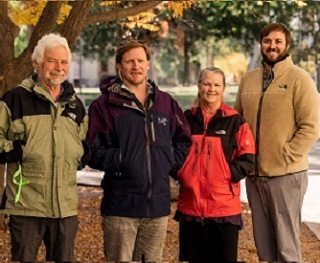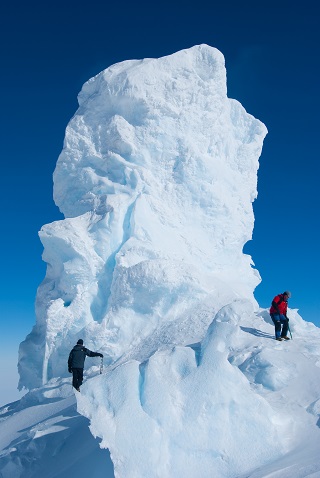
Dr. Matthew Zimmerer, Dr. Bill McIntosh, Dr. Nelia Dunbar, and Dr. Nels Iverson
Donate Now
Antarctica - Climate Knowledge Frozen in Time
Containing 90 percent of Earth’s ice and 70 percent of Earth’s fresh water, the complete melting of the Antarctic Ice Sheets is an absolute worst-case scenario in climate change - causing sea levels to rise over 200 feet, potentially altering the chemistry of the ocean, and doing untold harm to humans and wildlife.
 |
| Waesche Summit |
While the worst is not likely to happen in our lifetimes, polar temperatures are approaching those of the Last Interglacial Period, a time when the global sea level was approximately 20 feet higher than today and global temperatures were about 2°F warmer than the pre-industrial era.
Due to the lack of data, it is difficult to accurately estimate how much climate change will impact the stability of the Antarctic Ice Sheets and therefore how much future sea level is likely to rise. However, the ice holds valuable historical information that can help us better project future changes - and NM Bureau of Geology and Mineral Resources (Bureau) scientists are on the forefront of finding the secrets beneath the ice!
 |
| Dr. Bill McIntosh, Dr. Matt Zimmerer, Dr. Nelia Dunbar, and Dr. Nels Iverson |
Bureau scientists Dr. Matthew Zimmerer, Dr. Bill McIntosh, and Dr. Nelia Dunbar have an active National Science Foundation award of $370,173 to examine this problem. Collaborating with Bureau scientist Dr. Nels Iverson, they will examine the characteristics of volcanic rocks at a West Antarctic volcano, Mount Waesche, to learn about the past history of the West Antarctic Ice Sheet.
Samples collected from the lower flanks of the volcano will be analyzed to tell us the story of how ice sheets behaved during the Last Interglacial Period.
This research will inform a first of its kind dataset that will allow for the creation of more accurate modeling of how the ice sheets respond to a warming climate - potentially telling us whether there is a temperature threshold at which significant ice melt, and resulting sea level rise, occur.
 |
| Sauna Cave |
Bureau scientists, along with collaborators from University of Maine, spent their first field season in Antarctica in 2018/2019, and hope to return to the volcano to finish field work in 2024/2025. The delay between the two field seasons resulted from the COVID pandemic, which disrupted Antarctic fieldwork across the continent.
However, the researchers have been able to use this time to learn more about the eruptive history of Mount Waesche. The team has found that the volcano becomes much more active during interglacial periods, when there is less ice on the continent.
This is likely because the heavy weight of the abundant ice during cold, glacial periods creates pressure in the upper part of the Earth’s crust, keeping magma, or molten rock, from reaching the surface. When the ice sheets melt, the decrease in pressure allows magma to migrate to Earth’s surface and then erupt.
 |
| Ice Cave |
Bureau researchers are now working with faculty and students in the Earth & Environmental Sciences Department to better explain this phenomenon.
The current Mount Waesche research project is one amongst many Antarctic research projects that have been undertaken by New Mexico Tech since the early 1980s. The projects have focused on volcanoes, including active Mount Erebus, interactions between volcanoes and ice sheets, and ice core science.
This research, much of which has included international collaborators and is published in many international journals, has changed our understanding of how volcanoes and ice sheets work.